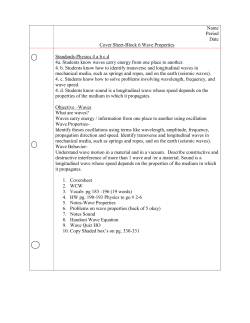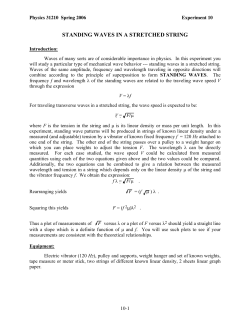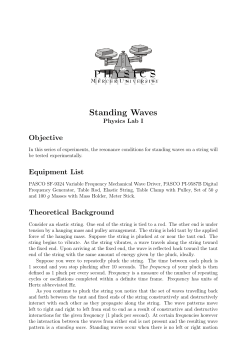
Water Waves and Tsunamis 1 Water Waves 1.1
Water Waves and Tsunamis 1 Water Waves 1.1 Speed of Water Waves Note: this is best read as an e-document due to the many external links! Shown below in Figure 1 is a schematic of a typical water wave, like the kind that occurs in the deep oceans. A water wave is neither longitudinal or transverse, but a combination of both. The path a bit of water makes as the wave goes by is actually a circle, as indicated in Figure 1. Towards the bottom of this web page1 is a nice animation of a water wave, with the circles representing little bits of water. Notice how they spin in a circle as the wave passes. This is another2 web page that shows a nice animation of a water wave. On this page, imagine a water wave far off shore, with one of the red dots being a seagull or log floating (or you on a surf board when you’re past the surf zone just relaxing in the sun). If that sight is familiar to you, you may remember that as a wave passes underneath, the floating thing seems to slosh back and forth, seeming to fall down the back of the waves. This is really just the circular motion of the water as the wave rushes underneath! Figure 1: A schematic of a wave traveling in deep water. The other thing to note about the water wave depicted in Figure 1 is that the amount which the water moves decreases as you get deeper, so that water about one-half the wavelength below the surface isn’t disturbed by the wave moving overhead. That depth is known as the wave base, and it is how we define whether or not a wave is traveling in deep water: Water is considered ‘deep’ for a wave, if it’s depth is greater than one-half of the wavelength of the wave. Otherwise, it is considered ‘shallow.’ 1 http://www.gmi.edu/∼drussell/Demos/waves/wavemotion.html 2 http://piru.alexandria.ucsb.edu/collections/geography3b/mike/Coastal_Pix/wave_animation1.gif 1 In deep water, the little circles of motion are not affected by the bottom of the ocean, lake, or mud puddle, and it turns out that the speed of the wave only depends on the wavelength of the wave: In deep water, the speed of a wave depends only on its wavelength, being roughly given by this equation: p Wave Speed = 1.25 × Wavelength Where the wavelength is in meters, and the speed given in m/s In shallow water, the situation is different. In this case, the bottom interferes with the circling of the deeper water, effectively causing a sort of friction, and slowing down the wave, as shown in Figure 2. The shallower the water, the greater the slowing effect and the speed of the wave only depends on the depth of the water: In shallow water, the speed of a wave depends only on the depth of the water, being roughly given by this equation: p Wave Speed = 3.13 × Depth Where the depth is in meters, and the speed given in m/s Figure 2: A schematic of a wave traveling in shallow water. 1.2 Waves Approaching Shore As waves approach the shoreline, they slow down. In order to keep their frequency constant, that means that their wavelength also has to decrease3 . In addition to that, the waves pinch together a bit, the front of the wave steepens (as surfers are well aware!), the height of the wave increases, and eventually the wave breaks. Here is an animation4 that shows all of these things happening. Why does the wave height increase? Just like all waves, the energy of the water wave is transmitted as kinetic energy and potential energy. The kinetic energy is tied up in the motion of the water– the little circles. The potential energy is tied up in gravitational potential energy– the amount the water is lifted above the still-water line (i.e. the amplitude of the water wave)5 . However, when the wave approaches the shore and enters shallow water, the circles on the bottom of the wave are compressed and the motion of the water stopped so that the kinetic energy that would normally be stored in the deeper part of the wave (the tiny circles in Figure 1) is lost. Some of this energy is lost to friction to the bottom of the ocean/lake/mud puddle, but a lot of it is conserved as gravitational potential energy! So that is why the height of the waves increases as they enter shallow water– the kinetic energy of the water near the bottom is being converted into potential energy of the water at the top6 ! Now why does the wave front steepen and the wave eventually break? Well, since the wave is is in shallow water, it’s velocity is determined by the depth of the water. For the water at the top of the wave, there is more water under it than the water at the bottom of the wave, so the top water tends to move faster than the bottom water7 This leads to the wave front steepening. Eventually, the top water has moved so far compared to the bottom water that it falls over– breaking. Again, refer to this animation8 . 1.2.1 Refraction of Water Waves Like all waves, water waves will refract. You undoubtedly witness this when you visit the ocean beach. When waves are far out from the shore (in deep water), they may be coming in at a sharp angle, relative to the coast line. But by the time they actually break upon the beach, they’re parallel to the coast line. A few examples of this are shown in the photographs in Figure 3. Why do waves tend to arrive parallel to the shore? As the water waves approach land, they begin to move into shallower and shallower water. This is equivalent to saying they move into a region their speed continually decreases. Just as sound waves do, water waves tend to bend towards the region where they move the slowest: shallow water. Since the shallow water is along the beach, they bend towards the beach, so that they tend to come in parallel to the shoreline. Figure 4 shows this in cartoon-form. In short, Waves bend towards shallow water. This is why waves break parallel to the shoreline. Besides leading to nice surf-lines, this is also what causes coastal erosion of headlands and the formation of arches and sea-stacks, examples of which are shown in Figure 5. The actual mechanism for this happening is shown in the cartoon in Figure 6. As the waves come towards land, the first shallow water they ‘feel’ is that surrounding the headlands. As a result, the waves (and the energy/momentum they carry) are preferentially focused onto the tips of the headlands. This leads to increased erosion of the headlands. The ‘Wave Refraction’ part of this animation9 nicely depicts how coastal erosion of headlands takes place. Arches are formed when there is a section of the headlands further inland that is weaker than the section closer to the deep ocean– so that it is eroded first despite being a bit more protected from the waves. A sea stack occurs when an arch collapses, leaving just the strong rock that used to be part of the headland sitting in the water by itself. 3 Remember the Wave Equation: speed = f requency × wavelength! 4 http://daphne.palomar.edu/lyon/Animations/WaveMotion.swf 5 Remember, a little part of the water gains a potential energy of mgh as the wave passes by an moves it up. that gravitational potential energy is given by the equation P Egrav = mass × accel. due to gravity × height. So for a little bit of water, the way to increase its potential energy is to increase its height. 7 There is another way to think of this: the water at the top is farther from the sandy bottom, so it’s not affected by it as much as the water near the bottom, which can feel frictional forces, etc. Therefore the top water moves faster than the bottom 6 Remember (a) Waves refracting as they approach shore. Original (b) A wave refracting at Stiges, Barcelona (Spain). Original imimage from this web page. age from this web page. Figure 3: Figure 4: Some examples of water waves refracting. A cartoon showing how water waves refract towards shallow water. water. 8 http://daphne.palomar.edu/lyon/Animations/WaveMotion.swf 9 http://daphne.palomar.edu/lyon/Animations/WaveMotion.swf (a) An example of a sea-arch near Cabo, (b) An example of a sea arch and sea stack. Mexico. Original image from this web page. Original image from this web page. Figure 5: Refraction focuses waves and their energy onto the tips of headlands, resulting in their erosion into sea arches and sea-stacks. Figure 6: A cartoon showing how water waves refract to erode headlands into arches and sea-stacks. As deep water waves approach the land, the shallow water around the headlands acts to concentrate the waves and their energy at the points, heightening erosion at the tips of the headlands. The energy of the waves that reaches the sandy coves is thus reduced, so that wave erosion isn’t so strong. 2 Tsunamis! What makes a tsunami so special? They are large waves, being generated by large underwater earthquakes or landslides, and tend to move very quickly. Buy why? Let us consider the Sumatran tsunami of December 26, 2004, which was caused by a magnitude ∼9 earth quake. This is a nice animation10 showing how the tsunami was created during that earthquake: basically, the bottom of the seafloor underwent enormous strains and suddenly gave away, generating a deep pressure pulse which gave rise to the Tsunami. Once the waves were created, they moved across the Indian ocean at very high speeds. 10 http://ffden-2.phys.uaf.edu/645fall2003_web.dir/elena_suleimani/generation_small.mov Here is a model11 of the tsunami traveling across the Indian ocean and towards the east coast of Africa. The red areas represent heightened water levels (crests) and the dark blue areas represend the suppressed water levels (troughs). Ignore the gridlines– they’r just part of the computer programming technique and are only interesting to data modelers and mathematicians. Watch how the wave propagates. You can estimate the wavelength of the tsunami most easily when the animation ends, and I think you’ll agree that it is in the neighborhood of 700 km. It’s a bit shorter nearer the epicenter12 , but we’ll take 700 km as a good estimate. Think about this number: 700 km. A typical ocean depth is 4,000 m, or 4 km. A very deep part of the ocean is around 10,000 m, or 10 km deep. Since the wavelength of the tsunami is so astronomically large compared to the depth of the ocean, the √ ocean is a mere mud puddle to it, so its speed is determined by the shallow-water equation: speed = 3.13 depth. Now we see why the tsunami is so incredibly fast: Since tsunamis have wavelengths many times longer than the depth of the ocean, their speed is determined by the shallow-water equation. In other words, the speed of a tsunami is proportional to the square root of the ocean’s depth! Estimating the speed of the 2004 tsunami, using 4,000 m as an average depth of the ocean we find: p speed = 3.13 4, 000 = 198 m/s ' 200 m/s = 720 km/hour Remember that the speed of sound in air is on the order of 340 m/s, so this wave was really going fast! Actual measurements pinned the wave’s speed between 600 and 800 km/hr, depending on the part of the wave. Another fact about tsunamis: in the open ocean, they may only have an amplitude of one meter or less (the 2004 tsunami was between 30 and 60 cm)13 . Once they hit the shore, they suddenly swell up to more than 10 meters high (the 2004 tsunami landed at ∼10 m high). Why is this? Just like normal breaking waves, the tsunami converts kinetic energy into potential energy. The difference is that the tsunami has huge amounts of kinetic energy stored in it. Imagine huge circles of water, spinning quickly– that’s a lot of kinetic energy! To convert that energy into gravitational potential energy requires the build-up of a very high wave– say 10 m or so! So what does a tsunami look like when it hits? Well, you may at first think of a wave like those out at Mavericks14 , only bigger, but they’re not like that. Consider again the 2004 tsunami: it had a wavelength of 700 km, and was traveling just a bit faster than 700 km/hour. That means that it has a period of roughly one hour. That means it takes about 30 minutes for the wave to crest, and 30 minutes for the trough to come in– very much different than a Mavericks wave, which breaks in a few seconds! So imagine what you’d see if you were on the coast of an incoming tsunami with that period. If the wave led with a trough, like the one that hit Thailand (look back at the tsunami animation, the wave going towards Thailand led with blue– a trough), you would see the level of the water drop by about 10 m (30 feet) over the period of about 15 minutes, then start to come back in. After 30 minutes, the water line would be back to normal, but then it would start to swell for the next 15 minutes until the water line was 10 m above normal, and then fall back to normal over the next 15 minutes. Here is an animation15 showing that. The other way a tsunami could hit is crest first, like the part of the waves that headed towards India and Africa in 2004. In this case, there would just be a surge, without any real warning. So that is how tsunamis do their damage: not through one big wave crashing down on the beach, but through massive flooding. They typically wash away everything within 100 m of the beach. Because a tsunami takes so long to come in, a young, fit person can generally outrun one. However, people ignorant of what a tsunami looks like coming in may get all excited when the water drops that they go and explore the bottom of the local bay– finding all sorts of cool things like stranded fish for dinner and things long-lost. However, they usually meet unfortunate fates once the water starts coming in. 11 http://www.math.utah.edu/simgeorge/movies/IndianOceanAmrMV.gif, it was also shown in class 12 Near the epicenter, the tsunami may have been between 50-100 km, as shown in look here). 13 This is one reason they’re so difficult to detect in the open ocean. 14 http://www.surftravelcompany.com/big-wave-pics/mavericks.jpg 15 http://ffden-2.phys.uaf.edu/645fall2003_web.dir/elena_suleimani/runup4.mov this animation (if you need a DivX driver,
© Copyright 2025





















